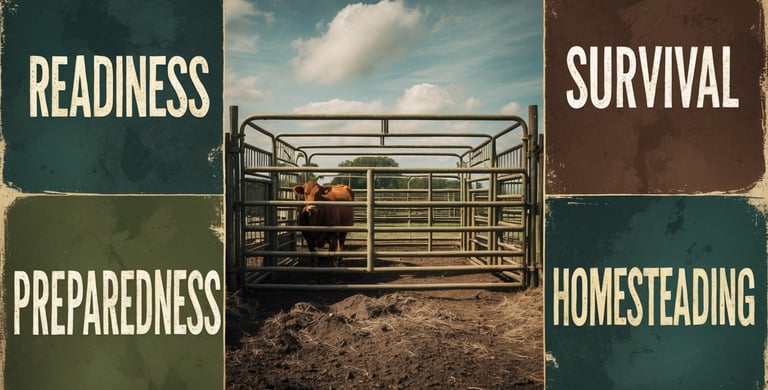Homesteading: Livestock Systems
Small Animals, Protein Production, and Responsible Stewardship
4FORTITUDER - READINESS, SURVIVAL, PREPAREDNESS, HOMESTEADING
Homesteading: Livestock Systems
Small Animals, Protein Production, and Responsible Stewardship
“He who tends animals not only feeds his house—but trains his children in dominion.”
— 4FORTITUDE Agrarian Canon
When the Stores Go Quiet, the Coop Must Speak
Meat is not a luxury in collapse—it is a source of strength, sustenance, and skill. But the modern man has forgotten how to produce it. His ancestors bred, bled, cured, and stored what they raised. He just swipes plastic.
Livestock systems are the heartbeat of the productive homestead. Not because animals are “cute,” but because they turn scraps into calories, pests into protein, and grass into strength.
This is not farming. It’s ethical, regenerative, tactical protein mastery.
Core Knowledge Foundation: The Four Pillars of Livestock Preparedness
Small-Scale Starter Livestock – Efficient, high-yield animals you can raise anywhere.
Feed, Shelter, and Lifecycle Management – Keep them healthy, secure, and producing.
Processing, Preservation, and Respectful Use – From life to legacy with moral clarity.
Rotation, Integration, and Waste Looping – Animals as systems, not accessories.
Misconception Warning: Livestock is not just food. It’s compost, defense, labor, income, and education. Mismanaged, it’s death and waste. Managed well—it’s a kingdom.
1. Small-Scale Starter Livestock
Goal: Raise meat and eggs efficiently, even with limited space.
Top Starter Choices:
Chickens (Dual-Purpose):
Eggs + meat
Breed: Buff Orpington, Rhode Island Red
6 hens = ~1,500 eggs/year
Rabbits:
Fast-reproducing meat (6–10 lbs per month per doe)
Quiet, minimal space
Use manure directly on garden
Quail:
Space-efficient egg + meat source
Start laying in 6 weeks
Ideal for stealth operations (suburban/urban)
Ducks:
Rich eggs, slug eaters, cold-hardy
Lay longer into winter than chickens
Drill: Choose one species. Build a small enclosure. Raise a pair or trio for 90 days. Track feed, waste, output, and behavior.
2. Feed, Shelter, and Lifecycle Management
Goal: Create humane, efficient systems that minimize cost and maximize sustainability.
Shelter Basics:
Chicken Tractor: Mobile coop that fertilizes as it moves
Deep Litter Bedding: Rotting straw absorbs waste, generates heat
Rabbit Hutch: Raised, shaded, cleanable system with manure catch
Feed Options:
Grain + forage (layer feed, pellets, kitchen scraps)
Black soldier fly larvae (grown on compost)
Sprouted fodder: barley or wheat, 7-day growth cycle
Duckweed, clover, and pasture rotation
Lifecycle Skills:
Culling sick or non-productive animals
Managing breeding pairs
Butchering with clarity, not cruelty
Drill: Build a 7-day feed cycle using scraps + homegrown fodder. Track food cost per pound of yield.
3. Processing, Preservation, and Respectful Use
Goal: Convert life to legacy without waste, fear, or excessive dependence on refrigeration.
Processing Methods:
Humane kill cone or cervical dislocation
Field dressing, plucking, skinning
Chill in saltwater brine or ice
Use every part (bones = broth, organs = nutrient bombs)
Preservation:
Canning (pressure): Long-term shelf meat
Dehydration: Jerky, cured strips
Smoking: Flavor + preservation
Salting and confit: Pre-modern techniques reborn
Moral Anchor:
Teach children to thank the animal. Use ritual language. Respect the life exchanged. This builds moral gravity into every calorie.
Drill: Attend or perform one chicken or rabbit harvest. Document each step. Preserve one portion with a non-electric method.
4. Rotation, Integration, and Waste Looping
Goal: Build animals into the garden, not separate from it. Everything feeds something.
Systems Thinking:
Chickens → Eat scraps + bugs → Fertilize soil → Feed garden
Rabbits → Create manure → Feed worms → Feed soil → Feed fodder
Quail → Minimal waste → Urban compost integration
Ducks → Mosquito control → Pond fertility → Aquatic feed loops
Rotation Examples:
Move tractors daily → reduce disease + spread nitrogen
Integrate animals post-harvest into garden beds
Use winter to breed, spring to raise, summer to butcher, fall to preserve
Drill: Design one full-cycle diagram: animal → feed → waste → garden → food → family. Walk it once per week.
Advanced Insights: Animals as Soul-Builders
Raising animals isn’t just tactical. It’s transformational.
It teaches:
Morning discipline
Clean death and reverence
Biological systems literacy
Gentle authority and earned dominion
Historical Anchor:
Ancient Hebrews, Romans, early Christians—all raised their meat. The shepherd wasn’t symbolic—he was a man of vigilance, sacrifice, and generational vision.
In collapse, you don’t just eat animals. You lead them. Teach through them. Feed through them. And live with their rhythm.
Critical Perspectives: “Livestock Isn’t Worth the Work”
Adversarial Viewpoint:
“Just hunt. Or buy meat. Raising animals is messy, inefficient, and cruel.”
Response:
That’s the voice of distance speaking. Once you butcher what you’ve fed, you stop wasting meat. Once you feed an egg-layer for 6 months, you start understanding time. And once your child helps care for rabbits—he becomes a builder, not just a boy.
Wisdom and Warning Duality
When Followed: You eat better. Waste less. Raise children in responsibility.
When Ignored: You rely on trucks. You fear hunger. You lose the rhythm of real food.
Strategic Crossroad: Will you produce protein—or pray it stays on the shelves?
Final Charge & Implementation
Brother, animals are not tools. They are partners. They turn time into food, waste into strength, discipline into culture. They ask of you daily vigilance—and return it tenfold.
Start Now:
Build the 4-Tier Livestock Entry Strategy
“The man who feeds his animals never begs for meat.”
Choose 1 starter species (chickens, rabbits, etc.)
Build micro-shelter from scrap
Create feed plan (store + grow)
Harvest one life this year—with reverence
Conduct the 30-Day Stewardship Trial
“Responsibility is not weight. It is crown.”
Feed and water daily
Record weight, mood, waste
Teach your child or spouse the entire loop
Prepare for birth, illness, death—before it happens
Strategic Reflection:
When meat becomes rare, and protein sacred… will your homestead go hungry—or rise?
Existential Challenge:
Do you own your food—or does a supply chain own your kitchen?
You don’t need acres. You don’t need perfection. You need clarity, care, and courage. Then, let the rooster wake your discipline… and the harvest answer your doubts.
“The man who raises his food never kneels before the grocery line again.”


